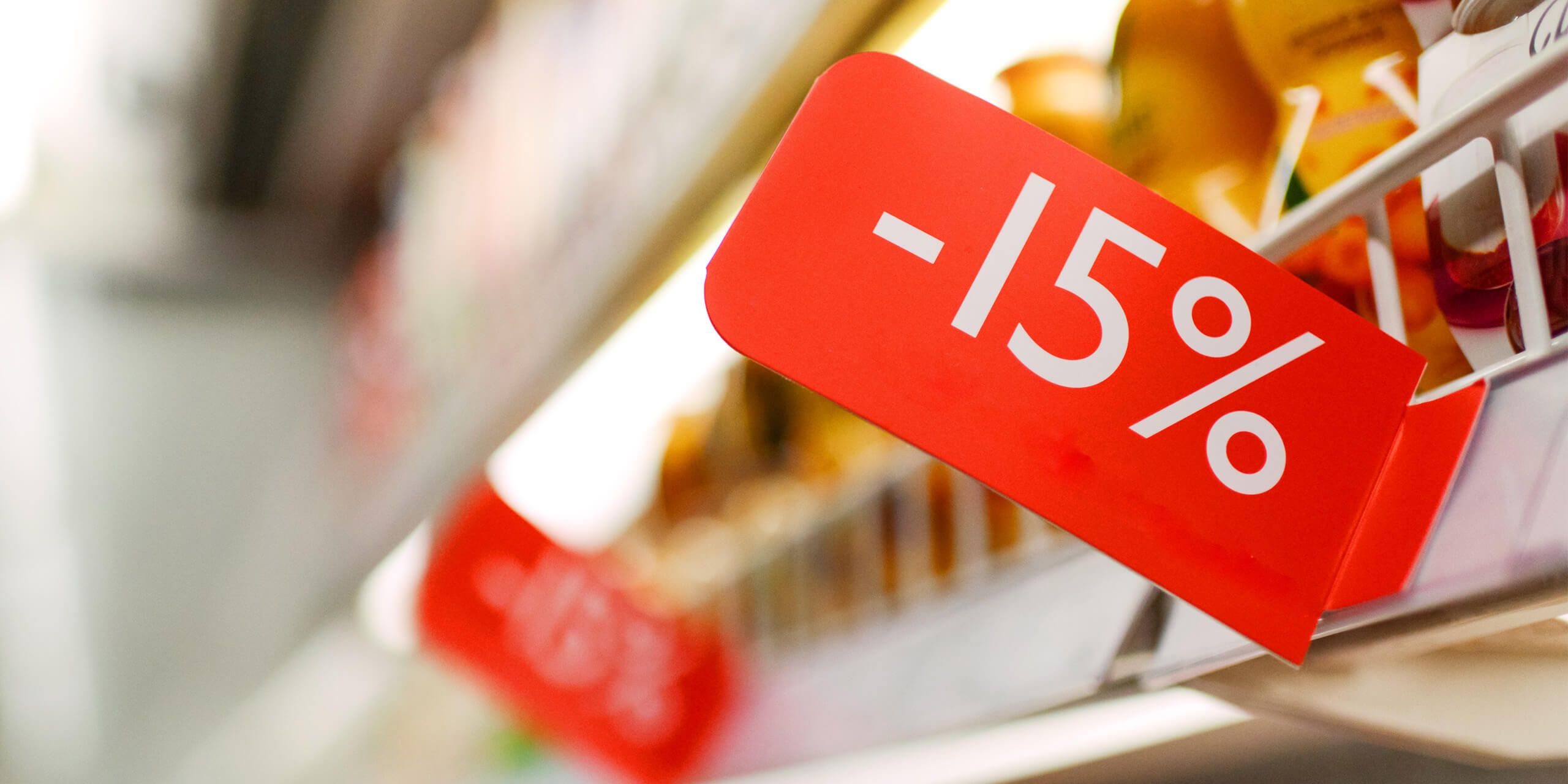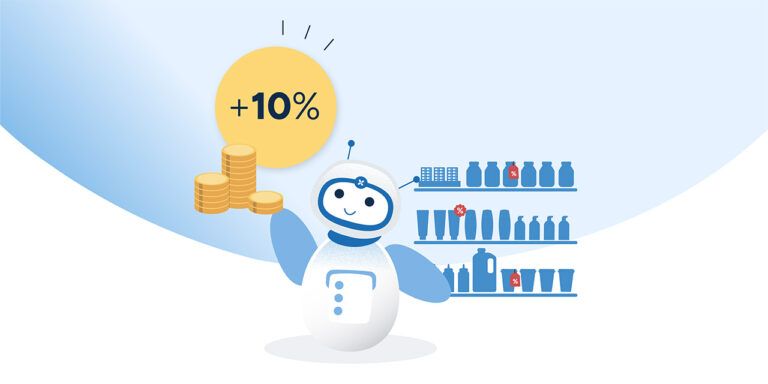Discount dynamics: Mastering the art of promotional pricing
May 7, 2024 • 11 min
Promotional pricing is challenging, but with the right strategy and tools, businesses can unlock profitability.
Picture this: A grocery chain launches a 50% off promotion on organic produce, aiming to outshine competitors and attract health-conscious shoppers. The campaign kicks off, drawing crowds, but the store’s inventory depletes rapidly. All the empty shelves leave customers disappointed. Competitors respond with similar discounts, diluting the impact of the promotion and straining the chain’s relationships with loyal customers.
Promotions can be highly effective, but they require a solid understanding of the opportunities and obstacles of expert pricing. In this example, the retailer wasn’t prepared with accurate data and a pricing strategy to maximize profitability during the promotion.
Let’s delve deeper into the specifics of promotional pricing, how it can benefit your brand, and the best strategies for successful promotions.
What is promotional pricing?
Promotional pricing is a short-term discount on product or service prices. These campaigns can serve various purposes, like clearing inventory, boosting customer engagement, responding to competition, or highlighting a special event.
The limited timeframe to receive a reduced price can stimulate demand and increase sales by creating a sense of urgency in customers. But mastering promotional pricing requires complex coordination across channels and sophisticated pricing analysis. These capabilities are essential to maximize profitability and avoid cannibalizing sales of regular-priced items while maintaining brand integrity and customer trust.
The limited timeframe to receive a reduced price can stimulate demand and increase sales by creating a sense of urgency in customers.
Without the right insight into important factors such as customer demand or profitability at various discount depths, effective promotional pricing can be nearly impossible to achieve. Yet when done right, promotional pricing is a fast way to boost sales.
Now that we’ve covered the overview of what promotional pricing is, let’s dig into some common types of effective promotional pricing and when to employ them.
Time-tested promotional pricing examples
Whether leveraging the appeal of volume discounts or strategically timing campaigns to coincide with seasonal sales trends, retailers have many promotional pricing options to drive sales and attract new customers. These tactics hold the potential to not only sway consumer decisions but also to unlock untapped profits and propel businesses to new heights of success.
Let’s explore some dynamic examples of promotional pricing strategies that can revolutionize your retail game.
- Single item discounts: Reducing prices can help retailers effectively target high-ticket items (where the savings are significant) and lower-priced goods (to encourage bulk purchases).
- Volume discounts: Offering a discount on larger purchases encourages customers to buy in bulk, increasing the average transaction size. Volume discounting is an effective strategy for products with long shelf lives or high repeat usage.
- Loyalty program discounts: Extending exclusive discounts to members of a loyalty program can enhance customer retention and increase the lifetime value of customers. This strategy also provides valuable data on customer preferences and buying habits.
- Campaigns: Aligning promotions with holidays or seasons (for example Halloween or back-to-school season) taps into heightened purchasing trends.
- Price matching: Matching competitors’ prices can attract price-sensitive shoppers and position your brand as the best value option. This strategy requires careful management to keep profit margins healthy.
If you know the right type of promotional pricing for your goals, you’ll see a number of benefits, from boosted profits to fierce customer loyalty. Let’s go over the top six benefits you could see from a promotion with the right pricing strategy for your goals.
6 key benefits of impactful promotional pricing
Unlocking the potential of promotional pricing can be a game-changer for businesses, offering advantages across a range of sectors. The benefits are multifaceted and impactful, from boosting sales and profitability to gaining market share and fostering customer loyalty.
1. Increase in sales and profitability
Retailers can drive incremental sales and make promotions more profitable by optimizing promotional pricing. Promotions often lead to a temporary increase in sales volume as promotions incentivize customers to purchase based on the perceived value of getting a good deal. This perception can be particularly effective during product launches, seasonal peaks, or inventory clearance periods.
Promotional pricing can also increase sales volume, improving cash flow in the short term.
2. Gains in market share
Companies that strategically offer discounts, incentives, or bundled deals can attract consumers who may have previously favored other brands. Attracting new customers this way is especially effective in industries where brand loyalty is moderate and consumers prioritize pricing.
Increasing market share boosts revenue and strengthens a company’s position in the industry. As market share expands, businesses can benefit from economies of scale, improved bargaining power with suppliers, and enhanced visibility in the market.
3. Customer acquisition
Attractive promotions can attract new customers who might not have considered your products or services. Once these customers are acquired, there’s potential to convert them into regular customers, expanding your customer base.
4. Greater customer loyalty
Well-crafted promotions can reinforce brand loyalty for existing customers by offering them value and appreciation. Exclusive deals for returning customers can make them feel valued and more likely to stick with your brand.
5. Improved inventory management
Promotional pricing can be an effective tool for managing inventory levels, helping to clear out old or excess stock to make room for new products. Promotional pricing can be particularly useful in industries with rapid product life cycles or seasonal variations.
6. Competitive advantage
Offering promotions can provide a competitive edge, especially if your business can offer more attractive deals than competitors. That competitive edge can be crucial in attracting price-sensitive customers and positioning your brand as offering great value – especially when inflation is driving up consumer costs and tightening budgets.
Despite the myriad benefits promotional pricing offers, navigating its landscape presents several formidable challenges you’ll need to look out for as you plan your promotion.
The toughest challenges in promotional pricing
When done right, promotional pricing significantly boosts sales volume and customer loyalty through high-level strategy, offer optimization, fund negotiation, and outcome evaluation. But too many brands rely on manual spreadsheets for promotion planning, a time-consuming process that’s error-prone. This often results in missed opportunities and inadequate stock levels, diminishing the effectiveness of sales initiatives.
Navigating the realm of promotional pricing also includes challenges – from complexities in data management and technological limitations to the delicate balance between enticing customers with discounts and preserving brand image. Failure to properly navigate these challenges can result in decreased sales and dissatisfied customers.
Difficulty reviewing past promotion pricing results
Assessing the true impact of promotional pricing on sales, profitability, and customer acquisition or retention can be complex. It requires robust analytics and the ability to attribute outcomes directly to the promotion.
Manual planning leads to guesswork and inefficiencies. Underestimating demand can lead to stockouts, while overestimating can result in excess inventory. Both scenarios can negatively impact customer satisfaction and profitability.
Fragmented promotion price planning
It’s common for pricing and promotions to be handled by separate teams working in separate systems — and a lack of alignment between systems almost always drives a wedge into cross-functional collaboration processes.
Unnecessary complexity when coordinating across departments increases the potential of pricing mismatches during promotion.
Implementing promotional pricing strategies requires coordination across multiple departments, including marketing, sales, supply chain, and finance. Misalignment among these departments can lead to execution challenges and diminished returns on promotional efforts.
Unnecessary complexity when coordinating across departments increases the potential for uneven pricing during promotions, undermining performance.
Technological and data difficulties
Technological and data challenges arise from scattered and incomplete promotion data. Examples might include not having proper data on what promotions were running, which items were included in a leaflet, or what proportion of sold items were picked up from a promotional endcap versus the regular aisle facing.
Furthermore, processes and responsibilities are spread out across departments throughout the promotion planning cycle. The resulting confusion often means important promotion data is incomplete or scattered across individually maintained spreadsheets. This fragmentation makes it harder to examine promotion performance and identify which levers will improve future performance.
Limited scenario testing and optimal discount level determination leaves pricing during promotions to little more than guesswork. Leveraging data analytics and AI for promotional pricing requires sophisticated technology infrastructure and data management capabilities, which can be a significant operational challenge for some retailers.
Predicting customer and competitor response
Promotions often obscure a product’s actual value for customers, who end up shopping solely based on deals, turning promotions into a habit that retailers find hard to break.
Without a clear rationale or insight into product performance, promotions soon become the norm — and can unintentionally manipulate demand. Frequent promotions can lead customers to expect discounts and delay purchases until the next promotion, potentially affecting regular sales cycles and profitability.
Promotions can also lead to decreased sales of non-discounted items, as customers opt for cheaper, promoted products instead. This cannibalization effect can dilute the overall profitability of the promotion.
You can also get in the way of your own success by getting caught up in price wars with competitors. In highly competitive markets, promotional pricing can lead to price wars where retailers continuously undercut each other’s prices, eroding margins industry-wide and creating a race to the bottom, where no one wins.
Frequent or overly aggressive discounting of any kind can harm a brand’s image, leading customers to perceive it as low quality or cheap. Maintaining brand value while using promotional pricing is a delicate balance.
And finally, don’t forget about supplier interaction. Suppliers (particularly for branded products) often sponsor promotions, sometimes challenging the balance of power with the retailer. Suppliers hold leverage because retailers depend on their products and financial support for promotions. This is reinforced by strong brand names and strategic partnerships. Negotiating power is often tied to the retailer’s size and market share.
To overcome these challenges, all you need are the right tools and the right pricing strategies. Now, let’s delve into actionable solutions. We’ll explore seven proven strategies designed to navigate these challenges and unlock the full potential of promotional pricing.
7 cutting-edge promotional pricing strategies
Strategic and insightful promotional pricing allows for smoother collaboration with suppliers, better forecast accuracy, and more satisfied customers — benefits that the right promotion planning software can help retailers achieve.
The key to avoiding potential promotional pricing pitfalls like eroding profit margins or damaged brand perception lies in the careful planning and execution of the right promotional strategies. The use of data analytics and customer insights to inform promotional pricing decisions can help maximize the benefits while minimizing the risks.
1. Review past promotions
Start by evaluating past promotions using a waterfall model. Include gross sales, baseline sales, and complex effects (like cannibalization). By analyzing these factors, you can assess the true impact of promotional pricing strategies on sales and profitability.
Calculate uplift or incremental ROI using “true lift sales” and “true lift profit.” These metrics help measure the effectiveness of promotional pricing strategies in driving sales and profitability.
Don’t forget about effects like switching, stockpiling, and halo effects when evaluating promotion effectiveness.
2. Leverage AI for decision making
Without support from AI and machine learning, retailers are hard-pressed to make informed, profitable pricing and promotional decisions.
AI not only enables to process and analyze the enormous amounts of data they generate around regular and promoted items — it gives a system the ability to learn automatically and improve recommendations using data alone. An AI-based planning system helps automatically identify patterns and insights human planners simply don’t have the time to calculate, leading to more effective, profitable promotions.
3. Adopt a unified, end-to-end system
Important data used when planning across departments also can be leveraged for advanced analytics and better decision making.
Maintain better consistency in strategy execution by integrating all pricing and promotion planning in a unified, end-to-end system that can do it all. This kind of solution allows for seamless adjustments based on recently updated data continuously coordinated across channels.
4. Incorporate customer-centric features in promotions
Always design promotions with the customer in mind. That might mean using guidelines, alerts, and approval workflows to ensure that promotions are relevant, timely, and appealing to your target audience.
5. Use actionable analytics and insights
Rely on analytics and insights to make data-driven decisions. Scenario testing can help predict the outcomes of different promotional strategies, allowing you to choose the most effective approach.
6. Laser focus on measurable value
Aim to provide measurable value through your promotions. Don’t settle for simply driving sales. Instead, you should also aim to build customer loyalty, improve profit margins, and reduce unnecessary costs.
7. Prioritize agility and responsiveness
The market and consumer preferences can change rapidly. Be prepared to adapt your promotional strategies quickly based on new data and insights.
We’ve covered a lot about promotional pricing — tactics, upsides, hurdles, and key strategies every retailer needs. Now, let’s dive into a real-life story that shows just how powerful effective promotional pricing can be in the wild.
A real-world promotional pricing success story: JJ Food Service
JJ Food Service Ltd. is a prominent omnichannel bulk food retailer operating across the UK with 11 branches and over 100,000 B2B customers. With a diverse inventory of 3,000 product lines, promotions play a significant role in their business. In fact, promotions contribute 15-20% of their turnover.
Unfortunately, managing promotions efficiently while balancing customer value and profitability posed a persistent challenge, ultimately growing cumbersome and prone to errors. The JJ Foods team needed a solution to streamline promotion management processes and enhance decision-making accuracy.
They turned to RELEX to alleviate the complexities associated with promotion management with seamless integration and strategic promotion planning. The JJ Food team discovered they were promoting some products at a lower price point without seeing any benefit. The retailer gained actionable insights into promotion pricing scenarios using predictive analytics. RELEX facilitated data validation, optimized product selection, and fine-tuned pricing to help the company make informed decisions for better promotion outcomes.
Within just a month of utilizing the RELEX promotional model, the company observed a 10% increase in sales volume and a 7% boost in promotional item profitability. By aligning promotions with customer segments and refining product selection, JJ Food Service achieved greater promotion efficiency and effectiveness. The enhanced visibility provided by RELEX empowered JJ Food Service to identify and capitalize on opportunities for further optimization, promising continued growth in sales volume and profitability.
JJ Foods Service serves as a great model of what’s possible with a smart strategy to promotional pricing. These kinds of results are possible for any retailer willing to develop a bespoke approach that’s informed by accurate data.
Amplify returns with powerful promotions
Pricing changes drive profitability, impact footfall, and influence consumer behavior. So why isn’t everyone seeing these benefits from promotions? The challenge lies in the complexity of planning and pricing promotions effectively.
Without a unified, end-to-end software platform providing comprehensive insights, retailers simply don’t have the insights to incorporate the myriad of data points needed for accurate promotional pricing. Utilizing an advanced promotional planning pricing solution is the key to meeting promotion goals.
With the solution in place, you can establish a clear strategy for promotion pricing and methodically progress towards that goal. Be sure to track key metrics like sales, profit, and ROI to make sure you’re achieving your goals and to help you plan your next promotion.
Ready to maximize your promotion planning efficiency? Explore our guide, “Promotion Planning & Optimization: How to Build a Case for Technology Investment,” for insights on leveraging real-life data to drive promotion success.




